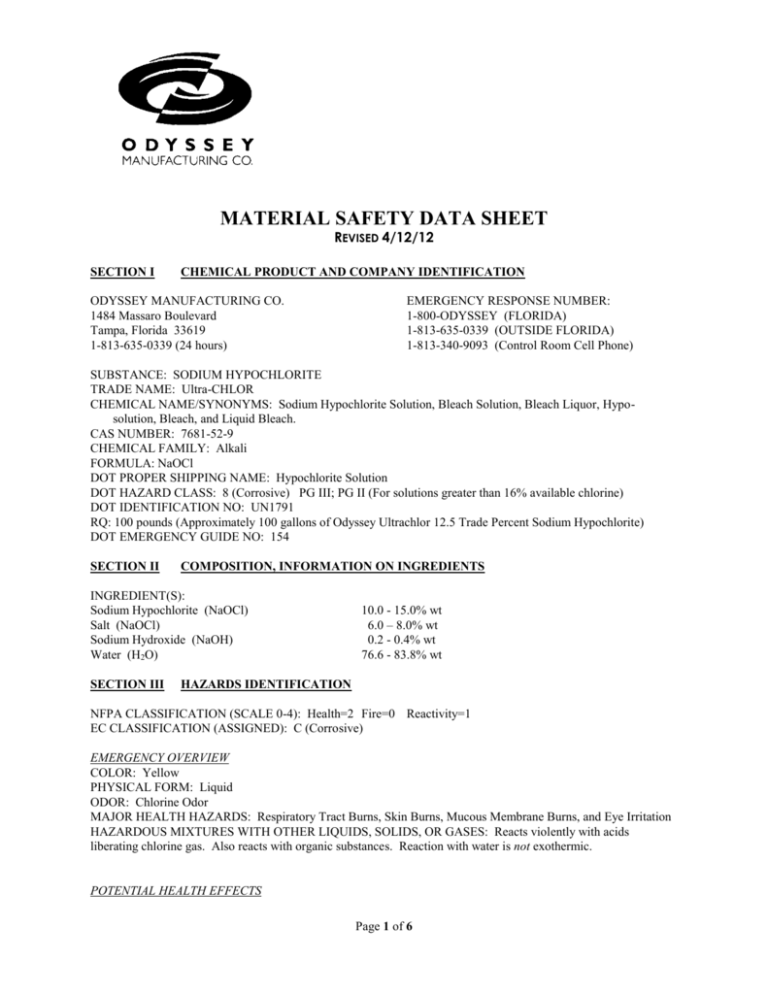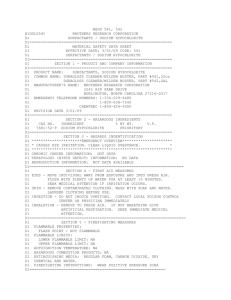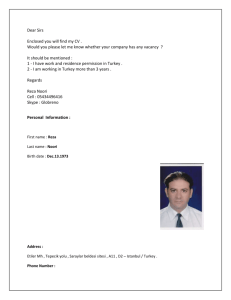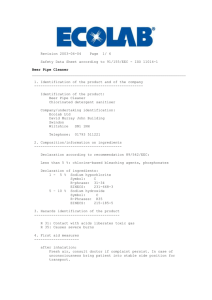MSDS Bleach PC - Gator Pressure Cleaning & Painting
advertisement

MATERIAL SAFETY DATA SHEET REVISED 4/12/12 SECTION I CHEMICAL PRODUCT AND COMPANY IDENTIFICATION ODYSSEY MANUFACTURING CO. 1484 Massaro Boulevard Tampa, Florida 33619 1-813-635-0339 (24 hours) EMERGENCY RESPONSE NUMBER: 1-800-ODYSSEY (FLORIDA) 1-813-635-0339 (OUTSIDE FLORIDA) 1-813-340-9093 (Control Room Cell Phone) SUBSTANCE: SODIUM HYPOCHLORITE TRADE NAME: Ultra-CHLOR CHEMICAL NAME/SYNONYMS: Sodium Hypochlorite Solution, Bleach Solution, Bleach Liquor, Hyposolution, Bleach, and Liquid Bleach. CAS NUMBER: 7681-52-9 CHEMICAL FAMILY: Alkali FORMULA: NaOCl DOT PROPER SHIPPING NAME: Hypochlorite Solution DOT HAZARD CLASS: 8 (Corrosive) PG III; PG II (For solutions greater than 16% available chlorine) DOT IDENTIFICATION NO: UN1791 RQ: 100 pounds (Approximately 100 gallons of Odyssey Ultrachlor 12.5 Trade Percent Sodium Hypochlorite) DOT EMERGENCY GUIDE NO: 154 SECTION II COMPOSITION, INFORMATION ON INGREDIENTS INGREDIENT(S): Sodium Hypochlorite (NaOCl) Salt (NaOCl) Sodium Hydroxide (NaOH) Water (H2O) SECTION III 10.0 - 15.0% wt 6.0 – 8.0% wt 0.2 - 0.4% wt 76.6 - 83.8% wt HAZARDS IDENTIFICATION NFPA CLASSIFICATION (SCALE 0-4): Health=2 Fire=0 Reactivity=1 EC CLASSIFICATION (ASSIGNED): C (Corrosive) EMERGENCY OVERVIEW COLOR: Yellow PHYSICAL FORM: Liquid ODOR: Chlorine Odor MAJOR HEALTH HAZARDS: Respiratory Tract Burns, Skin Burns, Mucous Membrane Burns, and Eye Irritation HAZARDOUS MIXTURES WITH OTHER LIQUIDS, SOLIDS, OR GASES: Reacts violently with acids liberating chlorine gas. Also reacts with organic substances. Reaction with water is not exothermic. POTENTIAL HEALTH EFFECTS Page 1 of 6 INHALATION: SHORT TERM EXPOSURE: Irritation to respiratory tract. May have same as effects reported in other routes of exposure, burns, blisters, nausea, difficulty breathing, and lung congestion. LONG TERM EXPOSURE: Same as effects reported in short term exposure. SKIN CONTACT: SHORT TERM EXPOSURE: Irritant, reddening of the skin. May have burns, blisters, and itching LONG TERM EXPOSURE: Same as effects reported in short term exposure. EYE CONTACT: SHORT TERM EXPOSURE: Irritation (possibly severe), possible eye damage LONG TERM EXPOSURE: Same as effects reported in short term exposure. INGESTION: SHORT TERM EXPOSURE: Burns, vomiting stomach pain, disorientation, bluish skin color, convulsions, coma LONG TERM EXPOSURE: Same as effects reported in short term exposure. CARCINOGEN STATUS OSHA: N NTP: N IARC: N SECTION IV FIRST AID MEASURES INHALATION: Remove from exposure and get fresh air. Use a bag valve mask or similar device to perform artificial respiration (rescue breathing) if needed. Keep warm and at rest. Get medical attention immediately if artificial respiration is required. SKIN CONTACT: Remove contaminated clothing, jewelry, and shoes immediately. Flush affected area with large amounts of water, preferably a safety shower. Use soap or mild detergent and large amounts of water until no evidence of chemical remains (at least 15-20 minutes). For burns, cover affected area securely with sterile, dry, loose fitting dressing. If skin is burned, get medical attention immediately. EYE CONTACT: Wash eyes immediately with large amounts of water, occasionally lifting upper and lower lids, until no evidence of chemical remains (at least 15 minutes). Continue irrigating with a normal saline solution until ready to transport to physician. Cover with sterile bandages. Get medical attention immediately. INGESTION: Rinse mouth with water. Drink large quantities of milk (water if no milk is available). Milk of magnesia may be helpful. DO NOT USE ACIDIC ANTIDOTES SUCH AS SODIUM BICARBONATE. When vomiting occurs, keep head lower than hips to help prevent aspiration. If person is unconscious, do not induce vomiting and turn their head to the side. Never make an unconscious person vomit or drink fluids. Get medical attention. NOTE TO PHYSICIAN: For inhalation, consider oxygen. For ingestion, avoid gastric lavage, emesis, sodium bicarbonate and acid solutions. Consider the use of antacids. SECTION V FIRE FIGHTING MEASURES FLASH POINT: Non-flammable FLAMMABLE LIMITS: Non-flammable FIRE AND EXPLOSION HAZARDS: Negligible fire hazard. Toxic fumes can be liberated by contact with acid or heat. EXTINGUISHING MEDIA: Regular dry chemical, carbon dioxide, water, or foam suitable for surrounding fire. For large fires, use regular foam or flood with fine water spray. FIRE FIGHTING: Wear self-contained breathing apparatus and full protective clothing. Move container from fire area if it can be done without risk. Cool containers with water spray until well after the fire is out. Stay away from the ends of tanks. Use extinguishing agents appropriate for surrounding fire. Do not get water directly on material. For large fires, flood with fine water spray. Reduce vapors with water spray. Apply water from a protected location or from a safe distance. Avoid body contact or inhalation of material or combustion byproducts. Stay upwind and keep out of low areas. SECTION VI ACCIDENTAL RELEASE MEASURES Page 2 of 6 OCCUPATIONAL RELEASE: Do not touch spilled material. Stop leak if possible without personal risk. For small spills, collect spilled material in appropriate container for disposal and consider absorbing with sand or other non-combustible material (e.g., do not use sawdust or other combustible material). Be advised, however, that the use of absorbing material is creating hazardous waste and this absorbing material must now be disposed of properly. Collect spilled material in appropriate container for disposal. For small dry spills, move containers away from spill to a safe area. For large spills, dike for later disposal. If possible, do not allow material to enter sewers, streams, ponds or storm conduits as concentrated solutions will seriously injure aquatic life. Keep unnecessary people away, isolate hazard area and deny entry. Contain in as small an area as possible, such as a holding area for dilution and neutralization. Contain spill in plastic drums when available. Dispose of in accordance with Federal, State, and local regulations. Personnel engaged in cleanup operations must be equipped with NIOSH approved respirator protection, rubber boots, gloves, and clothing to avoid body contact. Reportable Quantity (RQ): 100 pounds (approximately 100 gallons of Odyssey Ultrachlor 12.5 Trade Percent sodium hypochlorite). In the event of a spill (e.g., defined as any release to the environment), call Odyssey Manufacturing and/or the emergency contact numbers as soon as possible for assistance. For releases higher than the Reportable Quantity (RQ), you must notify the State Emergency Response Commission (U.S. SARA Section 304) at (800) 320-0519 AND the National Response Center at (800) 424-8802 or (202) 426-2675 (CERCLA Section103) within 15 minutes. Sometimes they will communicate with each other BUT DO NOT DEPEND ON THIS! ADVANCE PLANNING: Plan in advance for an occupational release and have necessary equipment and neutralization agents on-site. Contact Odyssey Manufacturing for assistance. SECTION VII HANDLING AND STORAGE Store in vented, closed containers that provide protection from direct sunlight. Keep separated from incompatible substances and do not store near acids, ammonia, heat, or oxidizable materials or organics. When handling, do not mix with other cleaning agents that may liberate chlorine gas vapors (e.g., acidic agents). Store and handle in accordance with all current regulations and standards. SECTION VIII EXPOSURE CONTROLS AND PERSONNEL PROTECTION EXPOSURE LIMITS: 2 mg/m3 AIHA recommended STEL 15 minute(s) for Sodium Hypochlorite VENTILATION: Provide local exhaust ventilation system. Ensure compliance with applicable exposure limits. EYE PROTECTION: Splash goggles are preferred to a faceshield. Another option is to wear splash resistant safety goggles with a faceshield. Provide an emergency eye wash fountain and quick drench shower in the immediate work area. CLOTHING: It is recommended to wear appropriate chemical resistant clothing to avoid body contact such as a rubber apron or rain suit. Boots are preferred for footwear. GLOVES: Wear appropriate chemical resistant gloves. RESPIRATOR: Under conditions of frequent use or heavy exposure, respiratory protection may be needed. Respiratory protection is ranked in order from minimum to maximum. Consider warning properties before use. Any chemical cartridge respirator with organic vapor cartridge(s). Any chemical cartridge respirator with a full facepiece and organic vapor cartridge(s) Any air-purifying respirator with a full facepiece and an organic vapor canister Any supplied-air respirator with full facepiece and operated in a pressure-demand or other positive-pressure mode in combination with a separate escape supply (Use for Unknown Concentrations or those that may be Immediately Dangerous to Life or Health) Any self-contained breathing apparatus with a full facepiece (Use for High Concentrations or those which are immediately Dangerous to Life or Health) SECTION IX PHYSICAL AND CHEMICAL PROPERTIES PHYSICAL APPEARANCE: Liquid APPEARANCE AND ODOR: Clear - Chlorine odor like household bleach. COLOR: Greenish –Yellowish cast MOLECULAR WEIGHT: 74.44 MOLECULAR FORMULA: Na-O-Cl BOILING POINT: Degrades at 230 Degrees Fahrenheit FREEZING POINT: 7 Degrees Fahrenheit SPECIFIC GRAVITY: 1.15 - 1.17 at 60 Degrees Fahrenheit Page 3 of 6 PH: Approximately 11 - 13 VAPOR PRESSURE (mm HG): Vapor Pressure of water + decomposition product Vapor Pressure VAPOR DENSITY: Not Available SOLUBILITY IN WATER: Complete VOLATILITY: Not Available EVAPORATION RATE: >1 COEFFICIENT OF WATER /OIL DISTRIBUTION: Not Available SECTION X STABILITY AND REACTIVITY REACTIVITY: Stable at normal temperatures and pressure. CONDITIONS TO AVOID: Avoid heat, flames, sparks and other sources of ignition. Dangerous gases may accumulate in confined spaces. May ignite or explode on contact with combustible materials. INCOMPATIBLES: Acids, metals, amines, combustible materials, reducing agents. Specific reactions with sodium hypochlorite include the following: ACIDS: Violent reaction. ALUMINUM: Corrosive action. AMINES: Form explosive chloramines. AMMONIA: Form explosive chloramines. AMMONIUM SALTS: May form explosive product. BENZYL CYANIDE (ACIDIFIED): Explosive reaction. CELLOLOSE: Violent reaction ETHYLENEIMINE: Forms explosive 1-chloroethyleneimine. FORMIC ACID: Explosive mixture. METHANOL: May form explosive compound. NITROGEN COMPOUNDS: Forms explosive N-chloro compounds. ORGANIC AND COMBUSTIBLE MATERIALS: Fire and explosion hazard. OXALIC ACID: Intense reaction REDUCING AGENTS: Fire and explosion hazard ZINC: Corrosive HAZARDOUS DECOMPOSITION: Thermal decomposition products – Chlorine and Hydrochloric Acid Vapors Decomposition Products – Hypochlorous Acid Vapors POLYMERIZATION: Will not polymerize. SECTION XI SODIUM HYPOCHLORITE TOXILOGICAL INFORMATION IRRITATION DATA: 10 mg eyes – rabbit moderate TOXICITY DATA: 1gm/ kg oral-woman; TDLo; 45mg/kg intravenous-man TDLo; 5800 mg/ kg oral-mouse LD5O; 140 mg/ kq/9 week(s) continuous oral-rat TDLo CARCINOGEN STATUS: According to the IARC, animal inadequate evidence, human no adequate data, Group 3 (Hypochlorite salts) LOCAL EFFECTS: Corrosive: inhalation, skin contact, eye, ingestion hazards ACUTE TOXICITYLEVEL: Slightly Toxic if ingested MUTAGENIC DATA: Mutation in micro organisms – Salmonella typhimurium 1mg / plate (-S9); DNA repair – Escherichiacoli 20ug/ disc; DNA damage – Esoherichiacoli 420 umol/L; phage inhibition capacity – Esoherichiacoli 103 ug/ well; micronucleus test - non-mammalian species multiple 200 ppb; cytogenetic analysis - non-mammalian species multiple 120 ug/ L; cytogenetic analysis – human lymphocyte 100 ppm 24hour(s); sister chromatid exchange – human embryo 149 mg/ L; cytogenetic analysis – hamster lung 100 mg/ L HEALTH EFFECTS: INHALATION ACUTE EXPOSURE: May cause severe bronchial irritation, sore throat with possible blistering, coughing, stomatitis, nausea, labored breathing, shortness of breath and pulmonary epedema. 10-20 mg/m3 causes burning of the nose and throat; 40-60 mg/m3 may be fatal. If sufficient amounts are absorbed, may cause effects as detailed in acute ingestion. CHRONIC EXPOSURE: No data available. Page 4 of 6 SKIN CONTACT ACUTE EXPOSURE: Extent of damage depends on concentration, pH, volume of solution and duration of contact. May cause redness, pain, blistering, itchy eczema and chemical burns. Sensitization reactions are possible in previously exposed persons. CHRONIC EXPOSURE: Effects depend on concentration and duration of exposure. Repeated or prolonged contact with corrosive substances may result in dermatitis or effects similar to acute exposure. Allergic dermatitis has also been reported. EYE CONTACT ACUTE EXPOSURE: May cause redness, pain, and blurred vision. Solutions of 5% splashed in human eyes have caused a burning sensation and later only slight superficial disturbance of the corneal epithelium which cleared completely in the next day or two without special treatment. However, one animal study reports a 5% solution causing only moderate irritation with clearing within 7 days. A higher concentration of 15% tested on rabbit eyes caused immediate severe pain, hemorrhages, rapid onset of ground-glass appearance of the corneal epithelium, moderate bluish edema of the whole cornea, chemosis and discharge for several days. Such eyes have sometimes healed in 2-3 weeks with slight or no residual corneal damage but they had neovascularization of the conjunctiva and distortion of the nictitating membrane by scarring. CHRONIC EXPOSURE: Depending on concentration and duration of exposure, symptoms may be as those of acute exposure. INGESTION ACUTE EXPOSURE: May cause irritation and erosion of the mucous membranes, vomiting (possibly bloody) and abdominal pain and spasms. A drop in blood pressure, shallow respiration, edema (possibly severe) of pharynx, larynx, and glottis, confusion, convulsions, delirium and coma may occur. Cyanosis and circulatory collapse are possible. Esophageal or gastric perforation and strictures are rare. Death may occur, usually due to complications of severe local injury such as toxemia, shock, perforations, hemorrhage, infection and obstruction. Massive ingestions may produce fatal hyperchloremic metabolic acidosis or aspiration pneumonitis. CHRONIC EXPOSURE: Sensitization reactions are reported in individuals who are exposed in small amounts through their water supply. High doses have caused sperm abnormality in mice. SECTION XII ECOLOGICAL INFORMATION ECOTOXICITY DATA: FISH TOXICITY: 94.0 ug/L 96h hour(s) LC5O (Mortality) Cutthroat trout (Oncorhynchus clarki) INVERTEBRATE TOXICITY: 31.6 ug/L 7 hour(s) 1C50 (Species Diversity) Protozoan phylum (Protozoa) ALGAL TOXICITY: 90 ug/L 96 hour(s) LC5O (Mortality) Algae, phytoplankton, algai mat (Algae) PHYTOTOXICITY: 230 ug/L 35 hour(s) (Biomass) Curled pondweed (Potamogeton crispus) OTHER TOXICITY: 2.1 ug/L 28 day(s) (Chlorophyll) Aquatic community (Aquatic community) ENVIRONMENTAL SUMMARY: Highly toxic to aquatic life. SECTION XIII DISPOSAL CONSIDERATIONS Subject to disposal regulations: U.S. EPA 40 CFR 262. Hazardous Waste Number(s): D001. Dispose in accordance with all applicable regulations. SECTION XIV TRANSPORT INFORMATION U.S. DOT 49 CFR 172.101 SHIPPING NAME-UN NUMBER: Sodium Hypochlorite) - UN1791 U.S. DOT 49 CER 172.101 HAZARD CLASS OR DIVISION: 8 U.S. DOT 49 CFR 172 .101 PACKING GROUP: III (less than 16% available chlorine) / II (16% or more available chlorine) U.S. DOT 49 CFR 172.101 AND SUBPART E LABELING REQUIREMENTS: Corrosive U.S. DOT 49 CFR 172.101 PACKAGING AUTHORIZATIONS: EXCEPTIONS: 49 CFR 173.154 NON- BULK PACKAGING: 49 CFR 173.203 (less than 16% available chlorine) / 49 CFR 173.202 (16% or more available chlorine) BULK PACKAGING: 49 CFR 173.241 (less than 16% available chlorine) / 49 CFR 173.242 (16% or more available chlorine) U.S. DOT 49 CFR 172.101 QUANTITY LIMITATIONS: PASSENGER AIRCRAFT OR RAILCAR: 5 LITERS / (less than 16% available chlorine) / 1 LITERS (16% or Page 5 of 6 more available chlorine) CARGO AIRCRAFT ONLY: 60 LITERS / (less than 16% available chlorine) / 30 LITERS (16% or more available chlorine) SECTION XV REGULATORY INFORMATION U.S. REGULATIONS TSCA INVENTORY STATUS: Y TSCA 12(b) EXPORT NOTIFICATION: Not listed. CERCLA SECTION 103 (40CFR302.4): Y SODIUM HYPOCHLORITE: 100 LBS RQ SARA SECTION 302 (40CFR355.30): N SARA SECTION 304 (40CFR355.40): N SARA SECTION 313 (40CFR372.65): N SARA HAZARD CATEGORIES, SARA SECTIONS 311/312 (40CFR370.21): ACUTE: Y CHRONIC: N FIRE: N REACTIVE: N SUDDEN RELEASE: N OSHA PROCESS SAFETY (29CFR1S1O.119): N STATE REGULATIONS: California Proposition 65: N EUROPEAN REGULATIONS: EC NUMBER (BINECS): 231-668-3 EC RISK AND SAFETY PHRASES: R 31 Contact with acids liberates toxic gas. R 34 Causes burns. S½ Keep locked-up and out of reach of children. S 28b After contact with skin, wash immediately with plenty of soap and water. S 45 In case of accident or if you feel unwell, seek medical advice immediately (show the label where possible) S 50 Do not mix with incompatible materials. CONCENTRATION LIMITS: C>10% C 5 % < = C <= l0 % Xi R 31-34 R 31-36/38 GERMAN REGULATIONS: WATER HAZARD CLASS (WGK): 2 (Official German Classification) SECTION XVI OTHER INFORMATION For additional information, contact our technical service department. Information contained in this MSDS refers only to the specific material designated and does not relate to any process or use involving other materials. This information is based on data believed to be reliable, and the Product is intended to be used in a manner that is customary and reasonably foreseeable. Since actual use and handling are beyond our control, no warranty, express or implied, is made and no liability is assumed by Odyssey Manufacturing in connection with the use of this information. Page 6 of 6







